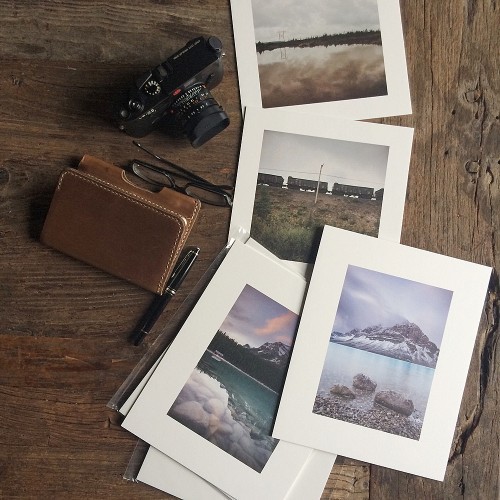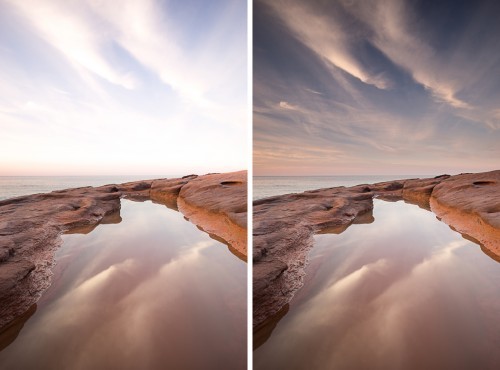David duChemin's Blog, page 21
November 10, 2014
About Critique
Popular photography education is awash in the idea that critique is helpful. God knows there are more than enough voices out there willing to give it, solicited or otherwise. And while I think it can be helpful, it often falls wildly short on the ability to provide that critique in a positive way. Nor, I think, does it give any guidance on how to choose those voices, or even what to do with that critique, once given.
I believe that getting honest critique, as hard as it is to both find it, and listen to it, is important in our growth as both craftsmen and artists. Taken from the right source, it helps us see our blind spots, which are by their very nature, almost impossible to see ourselves, like the bald spot at the back of my head, which took me years to see myself, and left me horrified that no one had told me. This was back when I had enough hair at the top to create the illusion. Again, from the right source, that criticism of our work can help us see where we’re heading and where that route might lead us to exciting new possibilities.
Critique culture has failed us, and most of all the beginners. It has held up moving, unattainable targets, encouraged individuals towards homogeny, and – perhaps most damaging of all, it has failed to take into account the vision of the artist. Picasso, Monet, Degas, Warhol – and almost any other artist of renown – would have been eviscerated by modern critique culture.
My earlier comments, that criticism from the right source can be helpful, needs qualification. Specifically: what is the right source? I don’t think anyone but you can answer that, but here’s what I would look for: has the person from whom you get this critique (just a french word for criticism, really, but doesn’t it sound much nicer?) earned your respect, by creating work that you respect and in a way that you respect? You don’t have to like their work. Hell, you don’t even have to like them. But you should respect them. The world is full of voices and everyone is an expert: there are photographers who have been using a camera for 2 years now giving workshops. And you know what, if they are creating work that you respect, they may very well have something you can learn from. But just because they have an opinion doesn’t mean it’s worth listening to.
So what makes it worth listening to? You have vision, whether it’s fully developed and discovered or not. That vision nudges you in certain directions. Your work, I hope, reflects that more and more. And the voices you listen to must be first willing to listen to your work and to your vision, because the two might not yet align, and only the voices willing to help you align those two are worth listening to. And that is exactly what’s wrong with online critique – too many people telling you what they’d have done differently, and none of them willing or able to first say, “What were you trying to accomplish with this?” or “This is what your work makes me think and feel, is that what you were hoping for?”
Consensus is not the point. It is never the point. Possibilities are the point. And an awareness of our blind spots, because we all have them. The voices that help us not only recognize the blind spots, but also help us see what we’re trying to see – in the way that we are trying to see – those are the ones I’d listen to. Otherwise we’ll bounce from opinion to opinion, down a never-ending rabbit-hole of viewpoints, and never get any closer to using this craft to make art that reflects our own unique desires. I’m not trying to be iconoclastic, but most of us would do very well to abandon the forums and the online critiques, and find a few well-chosen voices that are willing to listen before they speak, and when they speak, to speak from a desire to help us achieve our vision, not merely echo their own.
November 8, 2014
Inspired by the Tangible
Any company whose mission revolves around being inspired by the tangible and getting images off our devices and into our hands is a company run by people I want to hang out with.
So I’ve been ordering prints from Artifact Uprising and am seriously impressed with them – their quality and their service are spectacular. And their blog is inspiring, too. Go to the Ambassadors page, on which I am self-consciously featured among some truly talented people – people whose work you might just want to check out. I preach the “print your work, live with it, and share it” mantra a lot. But it’s not feasible for everyone to run out and buy a printer, never mind the inks and papers, a small print order – even a couple prints a month – gets you closer to real photographs on real paper.
So there’s two things I want to draw your attention to – the first is Artifact Uprising’s Square Print set – you get 25 beautifully printed photographs, all in square ratio so you can easily print images from your Instagram feed – for $21.99. Do that with your best 25 every month and after a year you’ll have 300 prints. If you like those but want something larger, their [Signature Print] offering, which is shown in the image above – is really beautiful – printed on thick matting medium, the prints are beefy and gorgeous. The ones above or 8×8 and 8×10 – 2 for $29.99. I’ve been creating paired images, and have this feeling I’m going to be filling my drawers (that didn’t sound quite right, did it?) and my walls, with more of these. And they do books and cards, though I have yet to order them, I’ll be doing books of this year’s adventures.
So – first things first, Artifact Uprising has given us a 10% discount on orders placed before the end of November – that code is: BLGDD1110. Enjoy!
Secondly, they’ve given me a $100 gift card to send to someone.
And, thirdly, I’m going to give away two of the prints they just sent me. I’ll sign them and put them in the mail to you, anywhere in the world, with my thanks for being part of this great community.
All you have to do is go check out Artifact Uprising, then leave a comment here on the blog (RSS readers, you’ll have to click through to the actual blog, sorry). I’m leaving to photograph polar bears next week and there will be some blog maintenance done over that time (2 weeks), so I’m going to do the draw a week from now, on November 15. First one drawn from the names in the comments (be sure to leave your email address, too, so we can tell you!) gets their pick of the prints or the gift card, the second one gets whatever’s left. And all of you get the discount. I hope you enjoy their work as much as I do – might make for some beautiful holiday gifts.
November 5, 2014
The Created Image, Vol.02
This July we hosted the second Created Image conference here in Vancouver. This time I was joined by Steve Simon and Piet van Den Eynde for this intense photography weekend. Over two days we talked about making compelling photographs – from learning to see and honing the skills that have nothing to do with the camera and everything to do with making images, to the power of visual storytelling, and the digital darkroom. What we packed into these two days of education was enough to stretch even the largest brains and hearts. And knowing that not everyone can afford the time or money to travel for an event like this, we filmed it, and after months of editing, we’ve cut it down to just over 12 hours of great content from three people who live and breathe this craft.
“The Created Image was a liberating experience, allowing me approach my photography from a new perspective.” – Dana Thomas
Here are the eleven (11) sessions in Volume 02 -
David duChemin
Beyond Looking, Learning to See
Without the Camera
Moments of Mastery
Toward Mastery, the Journey of Craft
Steve Simon
The Power of Photography
The Photographer, The Storyteller, 1
The Photographer, The Storyteller, 2
Piet van Den Eynde
The Digital Darkroom, Less is More
The Power of Black & White, 1
The Power of Black & White, 2
Dodge & Burn
Today we’re releasing The Created Image, Volume 02. It’ll be regularly priced at $50, but this week until November 11, 2014 at 11:59PM it is only $40. And if you haven’t yet watched Volume 01, you can get them together – over 26 hours of education and inspiration that will change the way you create photographs - yours to download or stream for only $80.
“A must-watch for those who love photography; inspirational as well as informational.” – Helen Dang
“The Created Image is a great way to rekindle that creative spirit – for an amateur, I found it a great way to break away from the routine, re-light that creative fire and to ask yourself what you want to achieve next.” – Chris Young
“As much as I was continuously inspired by the words and images presented, I felt this insatiable need to get out and photograph all the ideas that were emerging as a result of the workshop.” – Amy Brathwaite
Watch the Created Image, Vol. 02 teaser video:
November 3, 2014
Study the Masters: Elliott Erwitt
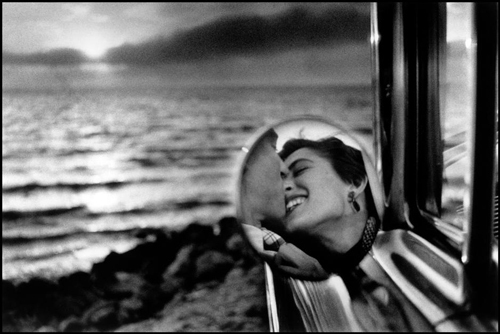 USA, California, 1955
USA, California, 1955  USA. 2000.New York city.
USA. 2000.New York city.
“It’s about reacting to what you see, hopefully without preconception. You can find pictures anywhere. It’s simply a matter of noticing things and organizing them. You just have to care about what’s around you and have a concern with humanity and the human comedy.” – Elliott Erwitt
Elliott Erwitt (1928 – present) is one of my favourite photographers. A photojournalist and commercial photographer, he is known for his black and white photographs of ironic and absurd situations within everyday settings. A master of timing, Erwitt has an incredible eye for juxtaposition.
Born in France in 1928 to Russian émigré parents, Elliot spent his formative years in Italy, his family immigrating to the US, fleeing the nazis, when Erwitt was ten years old. They first settle in New York, then two years later moved to LA. While attending Hollywood High School, Erwitt worked in a commercial darkroom that processed prints of movie stars for fans, and he went on to study photography and filmmaking at Los Angeles City College and the New School for Social Research. In 1949 began his professional career when he travelled to Europe, photographing Italy and France. In the 1950s he served as a photographer’s assistant in the US Army while stationed in France and Germany, eventually moving back to New York, where he met, and was heavily influenced by, Edward Steichen, Robert Capa, and Roy Stryker, all of whom became mentors to him.
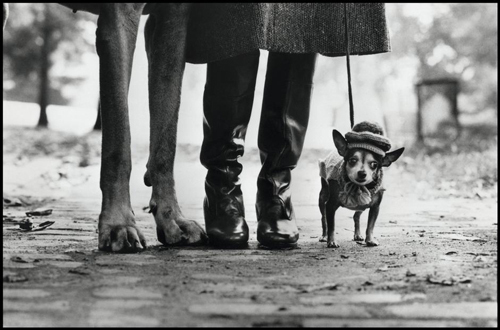 USA, NYC, Felix, Gladys, and Rover, 1974
USA, NYC, Felix, Gladys, and Rover, 1974
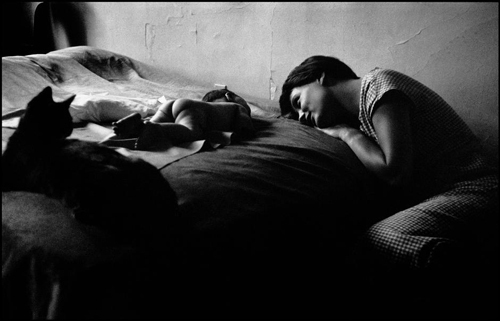 USA, New York City, 1953 (Erwitt’s wife looking at their baby)
USA, New York City, 1953 (Erwitt’s wife looking at their baby)
Erwitt went on to a freelance career, photographing for Collier’s, Look, Life, and Holiday, until eventually joining Magnum Photo Agancy in 1953 at Robert Capa’s invitation. He created a body of photojournalist work from around the world, also doing commercial assignments for companies like KLM, Chase Manhattan Bank, and Air France. Erwitt is still active with Magnum today. His books, journalistic essays, illustrations, and advertisements have been featured in publications around the world for over forty years.
There’s more to say about Erwitt. He strikes me as immensely creative individual who needs several outlets. In the 1980s he produced 17 comedy and satire television programs for HBO, and at one point created an alter ego to “satirise the kooky excesses of contemporary photography”: the beret-wearing, pretentious Andre S. Solidor (abbreviates to “ass”) who is “a contemporary artist, from one of the French colonies in the Caribbean, I forget which one.” I can’t think of another photographer I’d rather sit down over coffee with.
Studying Erwitt is, to me, as good as it gets. His work is deeply human, lacks pretense, and has a wit about it that’s unmatched. His sense of timing and composition is sublime. If Henri Cartier-Bresson conceived of the idea of the decisive moment, Erwitt perfected it.
All of Erwitt’s work is worth enjoying, and studying. Here are two I’d recommend, both quite different from each other. The first, Personal Best, is among my favourites.
October 29, 2014
Starting with Filters
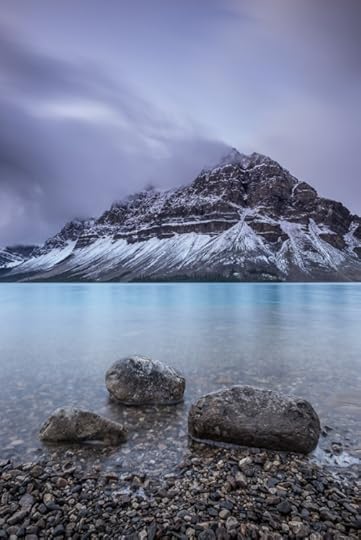 Banff National Park, Canada, 2014. I used both a full and graduated ND for this.
Banff National Park, Canada, 2014. I used both a full and graduated ND for this.
When I first started making photographs, optical filters (the ones you put on the front of the lens, as opposed to software filters) were common. You’d screw them to the front of the lens and it was all pretty simple. When I sold most of my 35mm gear to transition to digital, I sold my filters too, told that “you don’t use filters with digital.” What did I know?
Years later I use optical filters a great deal in my digital photography. There are things you can’t do in Lightroom or Photoshop – like replicate the effects of a polarizer, or a full Neutral Density filter. And if the dynamic range is too great, a graduated ND filter helps you get away from multiple exposures and blending layers later in Photoshop. On top of that, for me, the filters allow me to see possibilities. I can put a filter on, see the results, and react creatively, tweaking this, changing that, until I get something new and unexpected. If I did it later in the digital darkroom I’d be a long way from my scene when a change in direction suggested itself. I still make some frames without filtration, in case, later on, it turns out software is the best tool for the job, but I make those frames once I arrive at the image I want, and using optical filters gets me there.
 My Nikon with Lee Filter holder, polarizer ring (no polarizer) and one 3-stop graduated ND filter
My Nikon with Lee Filter holder, polarizer ring (no polarizer) and one 3-stop graduated ND filter
I’m writing this post is because I really wanted it when I was trying to figure out what I needed and how it all worked together. And I get this question a dozen times whenever I teach. So here’s what I use. But first, a disclaimer – this stuff isn’t cheap. If you want to use cheap filters, go for it – but you spend so much on quality lenses, I’m not sure why you’d want to degrade all that quality by putting cheap plastic in front of your lens.
I use the Lee Filter System. It begins with an adapter ring that comes in multiple thread sizes. That goes on your lens. Then the filter holder, a plastic square into which the filters – up to 3 of them, usually – clips on to that. That’s the basic set up. Now you slide filters into that. Unless you want to use a polarizer, then you need to add a large threaded ring to the front of the filter holder, onto which you can screw a large polarizer, enabling you to polarize a scene while also – for example – using a full Neutral Density filter to give you a long exposure, and a graduated ND filter for pulling the sky back. The filters themselves are usually either 4″x6″, made of high quality resin, or sometimes glass.
I simulated this in Lightroom, because all I had was the final filtered image, but the frame to the left is approximately what this scene would have looked like without a 3-stop hard-transition graduated ND filter
This is my kit, the one I have with me on most days when I’m photographing landscapes, are these, and for me they’re all I need (Amazon links. I do this to be helpful but if you don’t like affiliate links, just search for the same items on B&H or Adorama):
Lee Filters Foundation Kit / Filter Holder " target="_blank">Lee Filter Holder
" target="_blank">Lee Filter Holder
Lee Filters 105mm Lens Adapter Ring for the Basic Filter Holder Foundation Kit. " target="_blank">Lee Polarizer Adaptor
" target="_blank">Lee Polarizer Adaptor
Lee 105mm Circular Polarizer, Screw In Glass Filter " target="_blank">Lee Polarizer
" target="_blank">Lee Polarizer
Lee Filters Neutral Density .9 Graduated Hard Filter 6x4" Resin " target="_blank">Lee 3-stop (0.9) hard-transition grad ND
" target="_blank">Lee 3-stop (0.9) hard-transition grad ND
Lee Filters Big Stopper 10-stop ND Glass 100x100mm " target="_blank">Lee Big Stopper
" target="_blank">Lee Big Stopper
Lee Filters ND 0.9 (8x) 100x100mm (4x4") ProGlass Filter #9ND-G " target="_blank">Lee 3-stop full ND
" target="_blank">Lee 3-stop full ND
And if you have a 77mm thread on your lens, Century 77mm Lee Wide Angle Adapter Ring " target="_blank">you’ll want this adapter ring, which is specific to wide angle lenses. And here’s a link for Century 82mm Lee Wide Angle Adapter Ring
" target="_blank">you’ll want this adapter ring, which is specific to wide angle lenses. And here’s a link for Century 82mm Lee Wide Angle Adapter Ring " target="_blank">an 82mm W/A adapter ring. There are lots of other sizes, I’d recommend getting a couple of these, and cheaper step-down rings for any of the lenses you use less frequently.
" target="_blank">an 82mm W/A adapter ring. There are lots of other sizes, I’d recommend getting a couple of these, and cheaper step-down rings for any of the lenses you use less frequently.
I carry it all in a MindShift Filter Hive, which I’ve been using for 6 months now and wish I’d had one years ago. It clips to my belt or tripod and makes keeping it all in one place – and working with multiple filters – so easy. It even holds my filter holder, a lens cloth, and my cable release so everything I need for this kind of landscape work is all in one place.
If you want to go whole hog, Lee Filters Exclusive Kit includes FK Holder, 77mm Wide Angle Adapter Ring, Soft Edge Set, Hard Edge Set, Little Stopper and Big Stopper with 2filter cleaning kit " target="_blank">here is a link to a complete kit – it might be more than some of you need, but it contains almost everything I use (and then some!), except the polarizer and the ring for the polarizer. It contains the filter holder, a 10-stop ND, 6-stop ND, three hard-transition ND grads, three soft-transition ND grads, and some bits and pieces.
" target="_blank">here is a link to a complete kit – it might be more than some of you need, but it contains almost everything I use (and then some!), except the polarizer and the ring for the polarizer. It contains the filter holder, a 10-stop ND, 6-stop ND, three hard-transition ND grads, three soft-transition ND grads, and some bits and pieces.
A couple other helpful things:
Hard Transition Grad vs. Soft – I have both. I mostly carry the hard. I just like it better. But when the horizon is really interrupted by trees or mountains, the soft is a little easier to work with. Both is good. I’ll probably dig out my old soft-transition next time I’m out. I just never put it into the filter case.
Other Brands – There are other brands out there. For me, Lee is the sweet spot for quality and price. There’s Singh-Ray, and their quality is off the charts, but they’re pricier than Lee. And there’s Cokin, which I’ve used and will never use again. Unless they’ve stepped up their game, their filters have a (really, really) heavy magenta cast and are poor optical quality.
Colour Cast – Despite the name, Neutral Density filters aren’t always neutral, and you’ll notice a slight magenta cast if you stack them. The more you stack the more cast you get. It’s not (usually) a big deal, I even like that cast sometimes, but it can be alarming if you’re not expecting it. It can be easily removed in Lightroom.
I hope this is helpful. It’s probably still a little overwhelming. I found it confusing. But once I had the pieces – even a few of the basics – I couldn’t believe the difference in my photographs, and the process that got me to those images. Any questions about filters, leave them in the comments of this post and I’ll try to help clear the fog!
Hey, while we’re talking filters, you’ll probably want a tripod. Sure, you could just spend $1200 and buy one with a great ball-head, OR you could put your name in the pot to win one of my faithful Gitzos. It’s in great shape, but a guy can only use so many, so I’m giving one away. More information, and to enter, read this post.
October 27, 2014
Win My Tripod
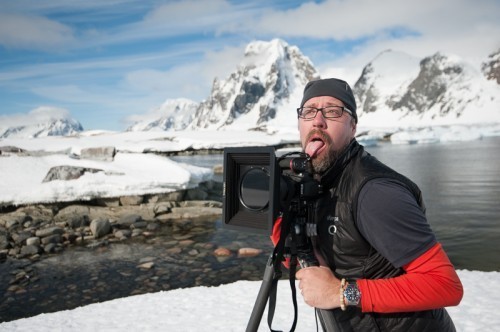 Me and one of my tripods in Antarctica. You will be getting a non-licked version.
Me and one of my tripods in Antarctica. You will be getting a non-licked version.
I have too many tripods. I know, I know, first-world problems. But my problem is your opportunity because we thought we could either throw one of these $1,200 Gitzos in the garbage (totally kidding), OR, we could give one away. I opted for the latter.
So, here’s the deal. I have a Gitzo GT3530LS, with a Gitzo ball head, attached to which is a Really Right Stuff quick release. It’s in great shape but it doesn’t get out much anymore and that’s a shame. So we’re making it simple – anyone that leaves a comment on this post gets entered into the draw, and in a week, we’ll give it away. And we’ll pay for postage. See how easy that was?
We’re doing this in conjunction with Craft & Vision’s Deal O’ The Week – this week that’s Dave Delnea’s Shoot the Look, Volume 01, a fantastic video series that will teach you a tonne about re-creating certain looks – from conception to camera-work to post-production in Lightroom, it’s all there. And while it’s usually $40, and I think that’s a great value, until November 4 at 11:59 PM (PST) it’s only $10. That’s 75% off, but for one week only. Check it out and be sure to watch the teaser video.
Now drop your name into the comments (below) and in a week we’ll be shipping this great tripod to a new home where I hope it’ll be as lovingly abused as my own are. *Make sure you give us your email address, if we can’t email you, we’ll pick someone else (’cause, um, how else are we going to know who you are. We will not be putting that address into a mailing list, that’s up to you.)
Want to be on the Craft & Vision newsletter so you don’t miss stuff like this? Sign up here. We send one email a week with great deals and featured inspirations and resources.
October 24, 2014
Study the Masters: Galen Rowell
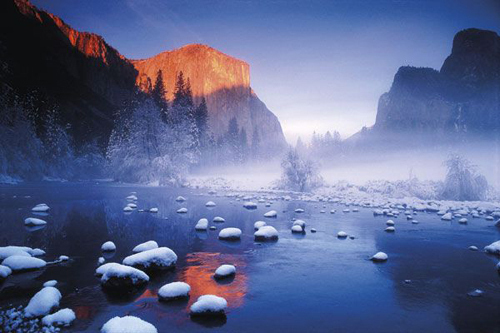 Winter sunset, Gates of the Valley, Yosemite National Park (California, 1990)
Winter sunset, Gates of the Valley, Yosemite National Park (California, 1990)
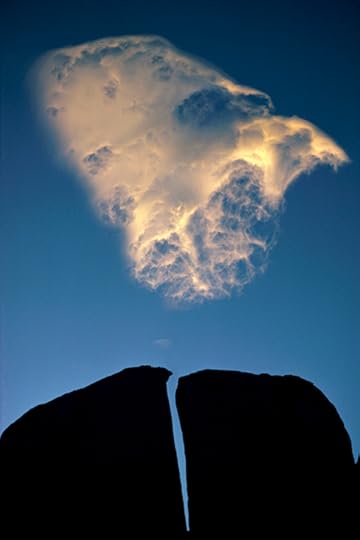 Split rock and cloud, Eastern Sierra (California, 1976)
Split rock and cloud, Eastern Sierra (California, 1976)
“Photography was a means of visual expression to communicate what I had seen to people who weren’t there. At first I was disturbed that 99 percent of my images didn’t look as good as what I had seen. The other one percent, however, contained some element–a beam of light, a texture, a reflection–that looked more powerful on film than to my eye. Without this I never would have been drawn toward photography as a career. I became fascinated with trying to consistently combine photographic vision and a visualization in my mind’s eye to make images that exceeded the normal perception before my eyes.”
Galen Rowell (1940-2002) was as much to this generation of outdoor, landscape, and conservation photographers as Ansel Adams was before him. Born and raised in California, he started climbing mountains at ten years old on Sierra Club outings, and by sixteen was making his first roped climbs in Yosemite. Over the next fifteen years he made over a hundred first ascents of new routes in Yosemite Valley and High Sierra backcountry. He was deeply accomplished, participating in major expeditions around the world. Rowell made the first one-day ascents of Mount McKinley in Alaska and Mount Kilimanjaro in Africa, and first ascents of Himalayan peaks such as Cholatse and the Great Trango Tower. In last 20 years of his life, cut short by a plane crash when he was 61, he made more than 35 journeys to the mountains of Nepal, India, Pakistan, China, Tibet, Africa, Alaska, Canada, Siberia, New Zealand, Norway, and Patagonia.
It was into this passion for adventure and the outdoors that he brought his Nikon film cameras, becoming a full-time photographer in 1972, selling his small automotive business to make the transition, and getting his first major magazine assignment less than a year later—a cover story for National Geographic. More than an observer, Rowell was an active participant in the images he made and, like Ansel Adams, advocated a very intentional creative process, and used similar words – like pre-visualization – to describe that process. And like Adams, who gave us the Zone System, Rowell pioneered the graduated neutral density filters, in collaboration with filter makers Singh-Ray, that many of us use today.
Galen collected the usual awards and accolades (if not more of them than many), saw his work published widely in Life, National Geograhic, Outdoor Photographer, and others, and published 17 large-format books of his work, both in images and text, relaying his passion and advocacy for the world, always coming home to the Californian Sierras he loved so much. Rowell perished,with his wife Barbara, in a small plane he was piloting, while coming home from a workshop in the arctic.
“Before Mountain Light the many magazines I had worked for never let me say what really motivated my work, and how different my style of participatory photography is compared to that of an observer with a camera who is not part of the events being photographed. It is the difference between a landscape viewed as scenery from a highway turnout and a portrait of the earth as a living, breathing being that will never look the same twice.”
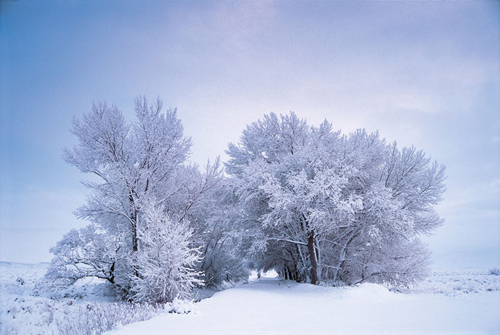 Frosted Cottonwoods, Owens Valley, Eastern Sierra, (2001)
Frosted Cottonwoods, Owens Valley, Eastern Sierra, (2001)
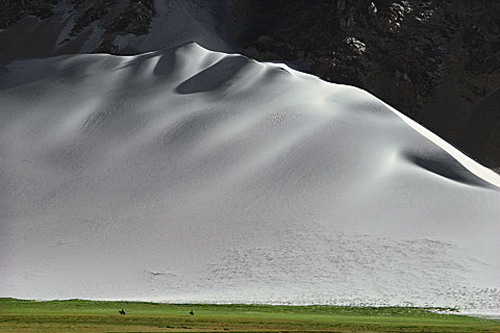
Horsemen beneath giant sand dune, Pamir Range (China, 1980)
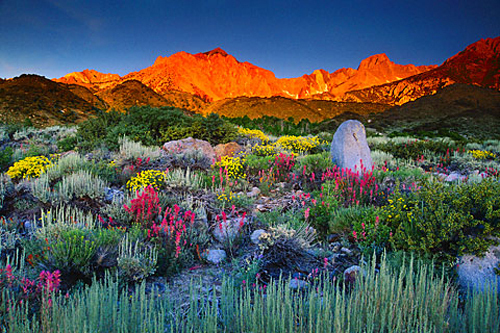
Summer dawn beneath Mount Humphreys, Eastern Sierra (California, 2001)
You can find Galen’s work on his website – MountainLight.com, but if you want more, I have all three of these on my shelves, and go back to them often. In fact, it’s probably time I cracked Inner Game open and visited my old friend, and mentor (from a distance; we never met) again.
Mountain Light: In Search of the Dynamic Landscape
Galen Rowell’s Inner Game of Outdoor Photography While this is not a book of photographs, per se, this one is a must-read to get into the heart and mind of one of the great modern landscape and conservation photographers. I know a number of photographers working today, myself included, that cut their teeth, or were strongly influenced by this book.
October 21, 2014
On Noise Reduction

Cavendish, Prince Edward Island
We fear missing out, so we read it all, and listen to every voice we can, seldom aware that by doing so we’re missing so much more.
This is not the post you think it might be. This is not about reducing the noise in your low-light, high-ISO, photographs. There’s software for that. This is about making your photographs better. Actually, it’s more than even that: it’s about becoming a better photographer.
The reason so many of us are floundering, especially photographers that are newer to the craft, is because we are listening to too many voices. There’s just too much. Too many forums and debates, too many new products and opinions on the same, too many advertisements clamouring and clamouring about hot tips, and short cuts, and newer! better! shinier! shoot like a pro!
Too many voices will not teach you more, they will confuse you. Too many voices will not make you more creative, they will paralyze you.
Could it be we’re all listening too much and seeing too little? I know it feels like education when we read twenty blog posts a day, but are we really learning? Are we really moving forward? If I had to bet, I’d say no. From my own experience, and listening to the frustrations of my students and readers, the more of this unfiltered noise that we listen to, the more paralyzed by options we become, the more we place our hope for better photographs in new gear/technique/software/fancycamerastrap, and the less we learn. Could it be that we’re deeply uncomfortable with the idea that mastering this craft will take some time (a lifetime, even?) and the only path to do that is to pick up the camera and go make photographs, without all these unfiltered voices rattling around in our heads?
The problem is that these voices are all saying different things. Everyone seems to have the secret, but everyone’s secret is different. So we bounce from one to another, a new technique, new lens, new camera, all in hopes of hitting upon the one magic thing. Look, I know I’ve preached this sermon before, but the only magic thing is to learn the basics, very carefully choose a couple voices at a time to listen to, and go out and make photograph after photograph after photograph.
Could it be that we’re deeply uncomfortable with the idea that mastering this craft will take a lifetime and the only path to do that is to pick up the camera and go make photographs?
Too many voices will not teach you more, they will confuse you. Too many voices will not make you more creative, they will paralyze you. The joy and the freedom comes when you come to the startling realization that the camera will take a lifetime of discovery to master, and you can make beautiful, compelling, photographs all the way along that journey, and that the true magic will be made only when you silence the voices enough to listen to the one voice that matters: your own.
A few years ago I took Tim Ferris’ advice about embracing a low-media diet. I stopped reading newspapers and watching the news. I made intentional decisions about the voices I listened to. We’re just not hardwired to absorb it all, much less do anything about it all. I’ve never looked back. I’m more focused and less distracted. I have more time to do the things I want to do and listen to the voices that truly enrich my life. I have the quiet I need to hear my own voice. I’m also happier. I think the same holds true for photography. We can only listen to so much.
If you were looking for unsolicited advice here it is, written with all the love and care I can have for friends and students I want so much to see succeed:
Turn it off. Find a couple voices you like to listen to. Voices that feel right. Voices that point you in solid directions. Voices that come from photographers that create work you love, in ways that you respect. And turn the rest off. Delete the bookmarks. Cancel the subscriptions to magazines that are 2/3 advertisements and empty promises. Spend the time on making photographs and the money on books filled with work you can learn from. For all I know, I could be one of those voices. I hope not. But I write a lot, and you probably don’t need to hear all of it. You have to choose what you consume. Even with good stuff. Even Vitamin C can be lethal in high doses.
Humans have only so much bandwidth. We have only so much time and attention, only so much emotional resource to give to those we love and do the things that matter most. Less is truly more. But we fear missing out, so we read it all, and listen to every voice we can, seldom aware that by doing so we’re missing so much more. Be selective, and pace yourself. And tune out any voice that isn’t helping.
This post comes hot on the heels of the 5DayDeal. Many of you downloaded thousands of dollars worth of resources for only, what, $90? It was a great deal. So are the products in the Craft & Vision store, or my books, but pace yourself. Choose your teachers, give them your attention, let them challenge you, but don’t cram it in all at once. Ingesting and digesting are two different things. 
October 20, 2014
Back in (and from) Banff
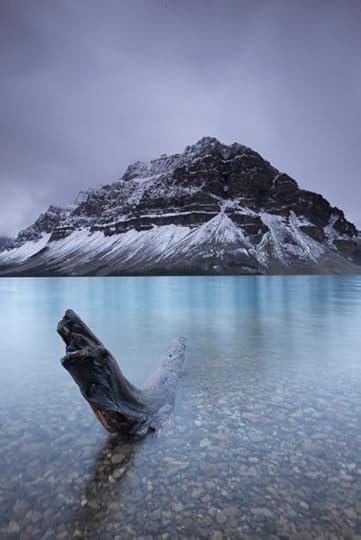
I got back from two and a half months on the road just in time to get a last minute invitation from friends Dave Brosha and Paul Zizka to join them in Banff for a workshop. Emergency laundry. Flights booked – my first in over 8 months. And then 3 long days teaching in some of the most beautiful places in Canada, if not the world. Now I’m home, tired, and really happy to have been a part of something so great, surrounded by wonderful people and wilderness. It’s the first workshop I’ve been a part of for a while and watching thirty photographers play, abandon the rules, and make room from wonder instead of just asking what f/stop to use, was inspiring to me. We spent hours talking, mostly informally, about the real work of the photographer – to be present, to be mindful, and to ever-conscious of the visual language. I couldn’t have asked for a better welcome back to the west. After so long in the Jeep it was nice to get outside my own head a while.
And now I’m back, the pile of errands and emails and business tasks before me, and all I really want to do it be up to my knees in water photographing a sunrise. Lots to do in the coming month before my next trip – two weeks with Polar Bears on Hudson’s Bay. This is the stuff people forget when they’re making their plans to “go pro” – the reality that our day to day is filled with work that’s almost completely unrelated to the making of photographs. It’s still creative work, or it should be if we’re to put our stamp on it, but it’ll now be a month before I look at a camera.
A quick thank you to everyone who bought the 5DayDeal package through me. I know we promote a lot of educational products, most them our own, but this one was too good not to pass up. On top of some great value, the crew that put this thing together (not me) raised almost $200,000 for some worthwhile charities. We ourselves will be sending $10,000 each to the Boma Project and the Kilgoris Project, and I know they’re going to do amazing things with that among people I love. So thank you. Affiliate sales are tricky, but I hope my being up front about these things, and promising to only promote what I believe in, and what I would buy myself, will keep it from feeling icky. It’s also part of how I make my living and support the team that works for me, so thank you.

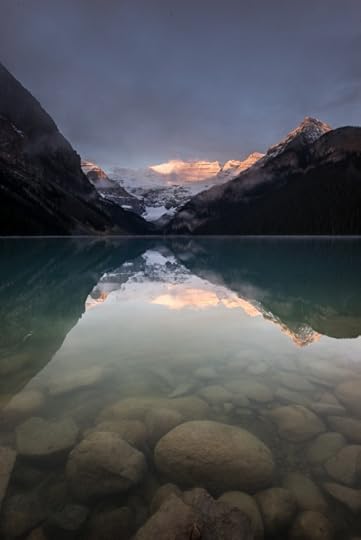
October 17, 2014
Study the Masters: Ansel Adams
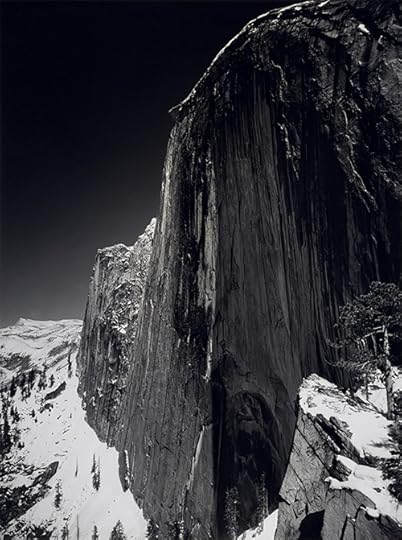 Monolith, The Face of Half Dome, Ansel Adams.
Monolith, The Face of Half Dome, Ansel Adams.
“I had been able to realize a desired image: not the way the subject appeared in reality but how it felt to me and how it must appear in the finished print”
When I started this series I knew I was going to have to write about Ansel Adams (1902-1984). People would roll their eyes and say, yes, we know Ansel. But, believing there remains a fundamental difference between being familiar with Adams’ work, and studying it, I still think there’s value in considering him a master. He is one of the giants on whose shoulders people like Edward Burtynsky, or Galen Rowell, stand (and stood). Sure, he’s been overplayed a little, like the Beatles’ Yesterday, but try to see it for what it was, and to see him for who he was, and learn something from both of those.
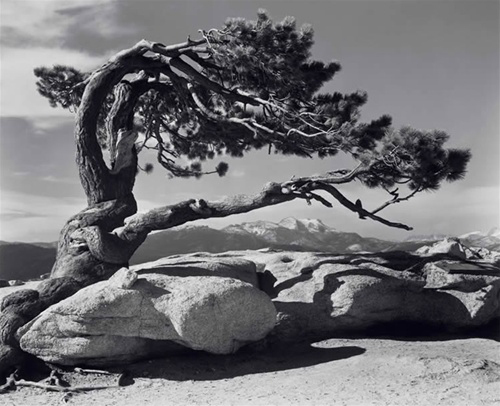 Jeffrey Pine, Ansel Adams
Jeffrey Pine, Ansel Adams
Ansel Adams was a defining figure in the romantic tradition of 19th century American landscape photography. He studied piano and planned to become a concert pianist before switching paths and becoming a photographer. He worked mainly with large format cameras in the American west, and was particularly known for his high contrast photographs of Yosemite, photographs that I carefully cut from calendars and put on my walls as a teenager, beside National Geographic covers from people like Steve McCurry, and photographs from the Patagonia catalogue. That sums up my early influence tidily. And like me, Adams seemed driven by more than a desire to make an accurate recording or pretty picture, but to move people to preserve a place he loved by creating in them a sense of mystery and the sublime. Like Burtynsky who I featured last week, Adams had an agenda – his photography supporting his environmentalist and conservationist hopes. Adams believed photography could create a strong emotional response in viewers, and his resulting efforts played a huge role in American conservation efforts of his time.
“More than any other influential American of his epoch, Adams believed in both the possibility and the probability of humankind living in harmony and balance with its environment.” – William Turnage
There’s much to learn from Adams. He still did commercial work to pay bills, but kept that work separate from his personal work, a model more photographers might consider, giving them both more creative and financial freedom. He played a role in furthering the craft, developing the Zone System with Fred Archer, and introducing early ideas about visualization. And his work was unique, speaking with a strength of individual voice that’s hard to ignore. His careful compositions, strong tonal contrast, and attention to the whole process – from vision to negative to print – might shame many of us who have become sloppy in our craft. Almost any of us now working in a landscape tradition have been influenced by Adams, even indirectly, and owe to him, in part, a debt for the place photography is slowly taking in the art world.
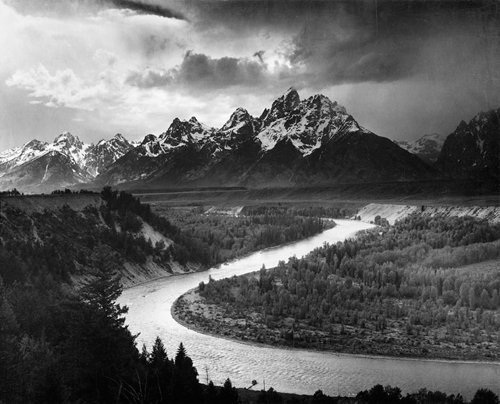
The Tetons and the Snake River, Ansel Adams.
You can learn more about Ansel Adams on the official website.
You can study his work in greater detail in these three, among many, books:
Examples: The Making of 40 Photographs
Ansel Adams: The Camera (The Ansel Adams Photography Series 1)


